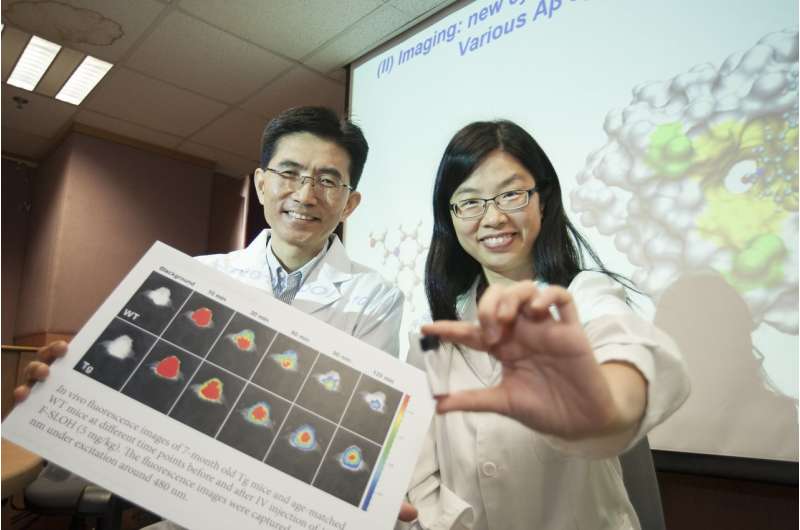Team develops world-first array of compounds for detection, imaging of Alzheimer's disease

Hong Kong Baptist University (HKBU) chemists have invented a new class of multifunctional cyanine compounds that can be used for detection, imaging and treatment of Alzheimer's disease. The research team was jointly led by Professor Ricky Wong Man-shing and Associate Professor Dr Li Hung-wing, with members from the Department of Chemistry of HKBU. By making use of the proprietary compounds, the HKBU team has proved that cyanine compounds applied on a nano-detection platform can quantify trace amounts of Alzheimer's disease-related protein biomarkers present in human fluids such as cerebrospinal fluid, serum, saliva, and urine. It is a rapid, low-cost and ultrasensitive detection assay. The compounds also serve as an imaging agent for in vivo detection and monitoring of disease progression and understanding the disease pathogenesis, as well as a drug candidate for treatment of the disease.
Alzheimer's disease is the most common neurodegenerative disorder. It is incurable, and the underlying cause is still not well understood. The condition is characterized by of amyloid plaque formation in human brains. Clinical evaluation, cognitive tests and neuroimaging (monitoring the brain's structural changes) are commonly used to diagnose Alzheimer's disease, but are only effective after symptoms appear. Moreover, neuroimaging, such as magnetic resonance imaging (MRI), requires injecting contrast agents that may bring health risks.
The proteins of interest, namely beta amyloid peptide, tau, and p-tau, in the cerebrospinal fluid are linked to Alzheimer's disease. The versatile detection assay requires only a minute amount of the sample fluids (a few microliters) to quantify the target proteins. The detection assay is fast, cheaper and more sensitive than commercially available biological methods.
Detection is based on the specific immuno-interactions between the target antigen and detection antibody that is immobilised on the surface of magnetic nanoparticles. The sandwiched immuno-assembly is then labeled with a newly developed turn-on cyanine compound that enhances the fluorescence signal, which is quantified by an imaging system.
Dr Li said, "This newly developed assay will be particularly useful as a low-cost, yet accurate diagnostic and prognostic tool for Alzheimer's disease. It can also serve as a novel alternative non-invasive tool for population-wide screening for the disease. This scientific detection assay has a high potential to serve as a practical diagnosis tool."
Dr Li said that the new approach is universal and general enough to be readily modified and further elaborated. Alzheimer's-related antibodies could be replaced with other disease-associated antibodies for a broad range of biomedical research and disease diagnostics.
The study, "Ultra-sensitive detection of protein biomarkers for diagnosis of Alzheimer's disease," was published in the internationally renowned academic journal Chemical Science.
In another related study, the research team discovered the cyanine compound that exhibits unique targeting on oligomers of beta-amyloid peptides and the strong fluorescence enhancement upon binding can serve as an imaging agent for in vivo detection and monitoring of disease progression and understanding the disease pathogenesis.
The beta-amyloid oligomers are formed from misfolding and self-aggregation of beta-amyloid peptide monomers, which grow further in size, giving rise to beta-amyloid fibrils and then senile plaques—one of the pathological hallmarks of Alzheimer's disease. Studies have shown that the oligomeric form are the most neurotoxic beta-amyloid species, and closely associated with the disease. Therefore, it is important to detect and image oligomers of beta-amyloid peptides more than any other kind of beta-amyloid. This compound has been successfully applied to detect and image beta-amyloid oligomers in young Alzheimer's disease transgenic mice models in early stages of the disease.
Furthermore, this newly developed compound displays excellent blood-brain barrier permeability, low biotoxicity, good inhibitory effect on preventing beta-amyloid monomers from self-aggregation and forming toxic oligomers as well as excellent neuroprotection effect against beta-amyloid-induced toxicities. Since this compound can suppress the neurotoxic oligomer formation and exert protection against the reactive oxygen species generation and calcium elevations of intracellular calcium ion, it shows great therapeutic potential.
This probe offers promising potential as a useful theranostic agent in early-stage diagnostics and therapeutics for Alzheimer's disease. The research team is currently studying in vivo efficacy on cognitive improvement in Alzheimer's disease mouse model.
More information: Yinhui Li et al, Fluoro-substituted cyanine for reliable in vivo labelling of amyloid-β oligomers and neuroprotection against amyloid-β induced toxicity, Chemical Science (2017). DOI: 10.1039/C7SC03974C
Hei-Nga Chan et al. Ultra-sensitive detection of protein biomarkers for diagnosis of Alzheimer's disease, Chemical Science (2017). DOI: 10.1039/C6SC05615F


















